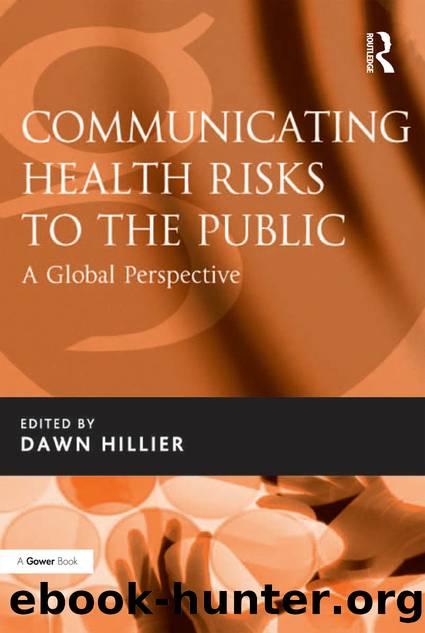Communicating Health Risks to the Public by Hillier Dawn;

Author:Hillier, Dawn;
Language: eng
Format: epub
Publisher: Taylor & Francis Group
Published: 2016-08-15T00:00:00+00:00
Politics, fear and health risk communication: examples from avian flu and HIV/AIDS
According to Barzani (2006) the number of Kurdish siblings succumbing to the highly pathogenic form of avian influenza is on the rise:
This deadly pandemic (bird flu) recently detected in Kurdistan continues claiming the lives of many underprivileged and improvised [sic, impoverished] Kurdish citizens in Kurdistan (Southeastern Turkey). According to some complaints filed, most affected Kurdish victims are being turned down proper hospitalisation or medical attention for symptoms that suggest avian influenza. Preventive measures on behalf of Turkish health authorities and international intervention appear inadequate.
Rumours abound that the spread of bird flu is part of the Turkish deliberate plot to multiply panic among Kurdish citizens, to mitigate their rural population (modern Turkification policy) and enforce a mandatory relocation into urban areas.
In Papua rumours are also rife, inspiring conspiracies as illuminated in the following quote published by Butt (2005):
This is what Iâve heard: Since the problem of Free Papua arose, AIDS has come here so that Papuans die off. There were these fallen women [perempuan sundal] from Jayapura, well they [the Indonesian government] brought them all to Wamena. And those who want those women can have sex with them. And the women brought the disease with them.
Butt informs us that according to widespread theorising among indigenous Papuans, âlipstick girlsâ and âfallen womenâ infected with HIV were introduced into Papua as part of an Indonesian programme aimed at eliminating indigenous people from the resource-rich province. Papuans have heard through media and gossip that the number of HIV and AIDS cases in the province are the highest per capita in Indonesia and that the province is on the verge of an epidemic. According to Butt, the core logic of Papuan theories about the causes for this links AIDS with political conditions of disempowerment and that such assertions are made by numerous Papuans from many places and walks of life.
Both HIV/AIDS and influenza in our times have become major international political dilemmas. In the case of influenza the question is, how do we prepare ourselves for a potentially catastrophic pandemic without generating widespread public panic? In the case of HIV/AIDS the questions remains, how do we halt the spread of the disease, encourage compliance with precautionary measures, treat people with the disease and ensure they maintain their drug therapy to avoid drug resistance?
Scholars have used the term ârumourâ to describe forms of talk to deal with, usually in a highly evocative symbolic manner, seemingly unrelated events. Taussig (1987) and Masquelier (2000) consider that these interpretations provide the means for people to make sense of political or economic conditions. Butt (2005) claims that in a number of societies, prostitutes and sexually transmitted diseases (STDs) have provided potent symbols in rumours of otherness, contagion, assault and invasion. Sexuality offers a salient marker of otherness while stigmatised prostitution particularly highlights external threats to communities (Jeffrey 2002; Stoler 2002). Treichler, for example, notes that in South Africa it is widely believed that AIDS enables control over the reproduction of blacks, a view that is also held by many Malawians (Hillier 1992 unpublished research).
Download
This site does not store any files on its server. We only index and link to content provided by other sites. Please contact the content providers to delete copyright contents if any and email us, we'll remove relevant links or contents immediately.
Application of a Novel Technique for Clinical Evaluation of Nitric Oxide-Induced Free Radical Reactions in ICU Patients by Unknown(696)
Rosenâs Emergency Medicine Concepts and Clinical Practice by Ron Walls; Robert Hockberger; Marianne Gausche-Hill; Timothy B. Erickson; Susan R. Wilcox(572)
Oxidative damage to surfactant protein D in pulmonary diseases by Vitality Starosta1 & Matthias Griese1†(408)
Social Science Perspectives on Global Public Health by Vincent La Placa & Julia Morgan(373)
Constructing Canine Consent; Conceptualising and Adopting a Consent-focused Relationship with Dogs by ERIN JONES(330)
Organic Chemistry: An Acid - Base Approach by MICHAEL SMITH(299)
ADVANCED EMERGENCY CARE AND TRANSPORTATION OF THE SICK AND INJURED by Unknown(271)
Saunders Nursing Drug Handbook 2024 - E-Book by Unknown(263)
Socio-Life Science and the COVID-19 Outbreak : Public Health and Public Policy by Makoto Yano; Fumihiko Matsuda; Anavaj Sakuntabhai; Shigeru Hirota(246)
Diagnostic and Statistical Manual of Mental Disorders, Fifth Edition, Text Revision (DSM-5-TR(tm)) by Unknown(246)
Davis's Comprehensive Manual of Laboratory and Diagnostic Tests with Nursing Implications by Unknown(245)
Human Microanatomy; Cell Tissue and Organ Histology with Celebrity Medical Histories by Stephen A. Stricker(243)
Berne and Levy Physiology E-Book by Unknown(234)
Replacing the Dead by Mie Nakachi;(229)
Handbook of Skin Disease Management by Jiyad Zainab;Flohr Carsten; & Carsten Flohr(228)
Access to Medicines and Vaccines in the South : Coherence of Rules and Policies Applied by the European Union Commission by Stephen Kingah(225)
The Pocket Guide to Sensorimotor Psychotherapy in Context (Norton Series on Interpersonal Neurobiology) by Pat Ogden(218)
Deep Learning and Medical Applications by Unknown(217)
Advances and Technical Standards in Neurosurgery by Unknown(214)
